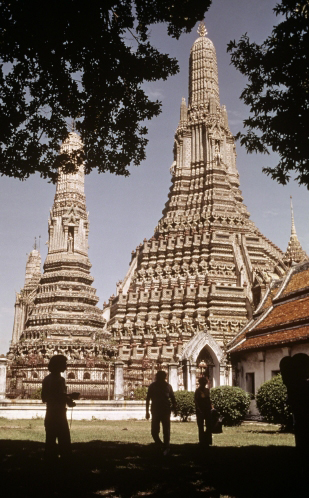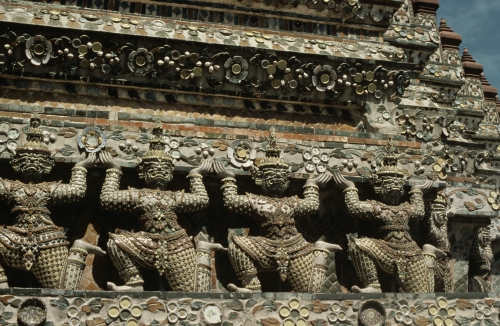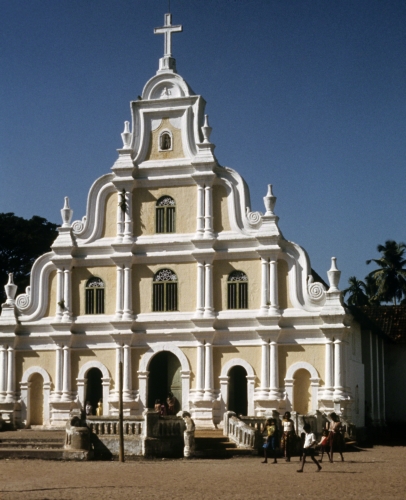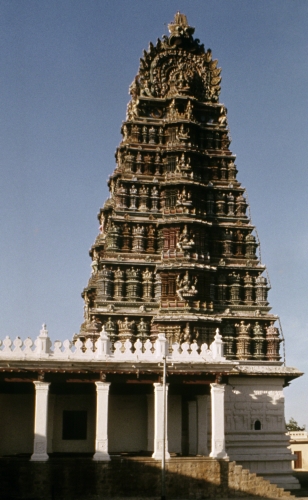"General" Redefined: Architecture Views
I’m sick, after a week or two, of hearing general-bashing in the news. And for what? Really??? I’d rather hear the government debating about more funding for education. But, I digress. So, I decided to redefine the idea of “general.” I offer you a few GENERAL views of gorgeous (GORGEOUS) buildings in Bangkok, Mysore City, and Cochin. And now, let’s sink into art history…
 |
| Thailand, Wat Arun, begun 1842. Photo © Davis Art Images. (8S-10325) |
Based on archeological findings in Ban Chiang, it is believed that Thailand had a sophisticated culture as far back as 3500 years ago. It is one of the few countries in the world that was never colonized. Apparently, the early Thai peoples migrated to various regions throughout Southeast Asia. Until the 13th century, the Mon and Thai people controlled the southern and northern areas of what now is Thailand. The Mon were of the same lineage as the Khmer in Cambodia and later settled in Burma (or Myanmar). The Khmer culture ruled the Mon civilizations from Cambodia, and influenced the development of Buddhism in Thailand, although there were native animist beliefs as well.
In the 13th century, Thai chiefs united to form the Sukhotai kingdom, the first truly independent Thai kingdom. Although short-lived, the period is considered the most culturally significant in Thai history, as Thailand established contacts and gleaned artistic influences from China, India, and Cambodia. The Ayutthaya period (1300–1767) was a long period of territorial expansion, increased international contacts (including Europe), and periodic war with Burma. After the Burmese devastated the capital of Ayutthaya, it was moved by the new dynasty to Bangkok.
 |
| Thailand, Wat Arun, detail, begun 1842. Photo © Davis Art Images. (8S-10328) |
Wat Arun was begun under the Chakri king Rama III (reigned 1824–1851), and work continued under Rama IV (reigned 1851–1868). Rama IV lived as a Buddhist monk for 27 years, and much attention was paid to the decoration of Wat Arun. It was built in a formula established during the Angkor period in Cambodia (ca. 9th–13th centuries): a central tower (prang) on a platform, surrounded by four smaller towers. A unique aspect to some Thai architecture, such as War Arun, is the decoration of the façade of the towers with broken Chinese ceramic pieces that marvelously reflect sunlight. These fragments came from the ballast of the numerous Chinese ships doing trade with Thailand, and from the numerous ceramics kilns established by Chinese emigrant artists.
And, another couple of “GENERAL” views:
 |
| Dutch Colonial, Saint Thomas Church, 1700s. Kochi (Cochin), India. Photo © DavisArt Images. (8S-10139) |
Kochi is a city on the west coast of India that has been a major trading port since ancient times. It was the center of the spice trade and was known by the ancient Greeks and Romans, Chinese, and Saudi Arabians. After the 14th century it became a major focus of European “colonization” (domination), first the Portuguese, then the Dutch, and then, ultimately, the British.
This church is a synthesis of Baroque and Rococo architectural styles from Europe. The stepped gable is definitely Baroque, while the volute shapes between each step hint at the Rococo style which was characterized by flowing arabesques. Although it must have seemed peculiar to the native Indians compared to their own architecture, it bears a striking similarity in vertical emphasis to traditional Indian temple architecture:
 |
| India, Chamundi Hill, Mysore City, GENERAL view, 1100s and 1800s. Photo © Davis Art Images. (8S-10140) |
Studio activity: Design a building with a personal purpose. Use markers, pencils and colored pencils. Design a building based on basic geometric shapes that imitate the overall emphasis of the three buildings in this blog post. Use horizontal and vertical lines to set up the building’s basic shape, keeping in mind that buildings are usually conceived of as units of geometric shapes. Add decoration and organic shapes to enhance the basic geometric units.
Correlations to Davis programs: Explorations in Art Grade 1: 2.12; Explorations in Art Grade 4: 3.15, 3.18; Explorations in Art Grade 5: 2.12; Exploring Visual Design: 2, 6, 8; The Visual Experience: 11.1


Comments